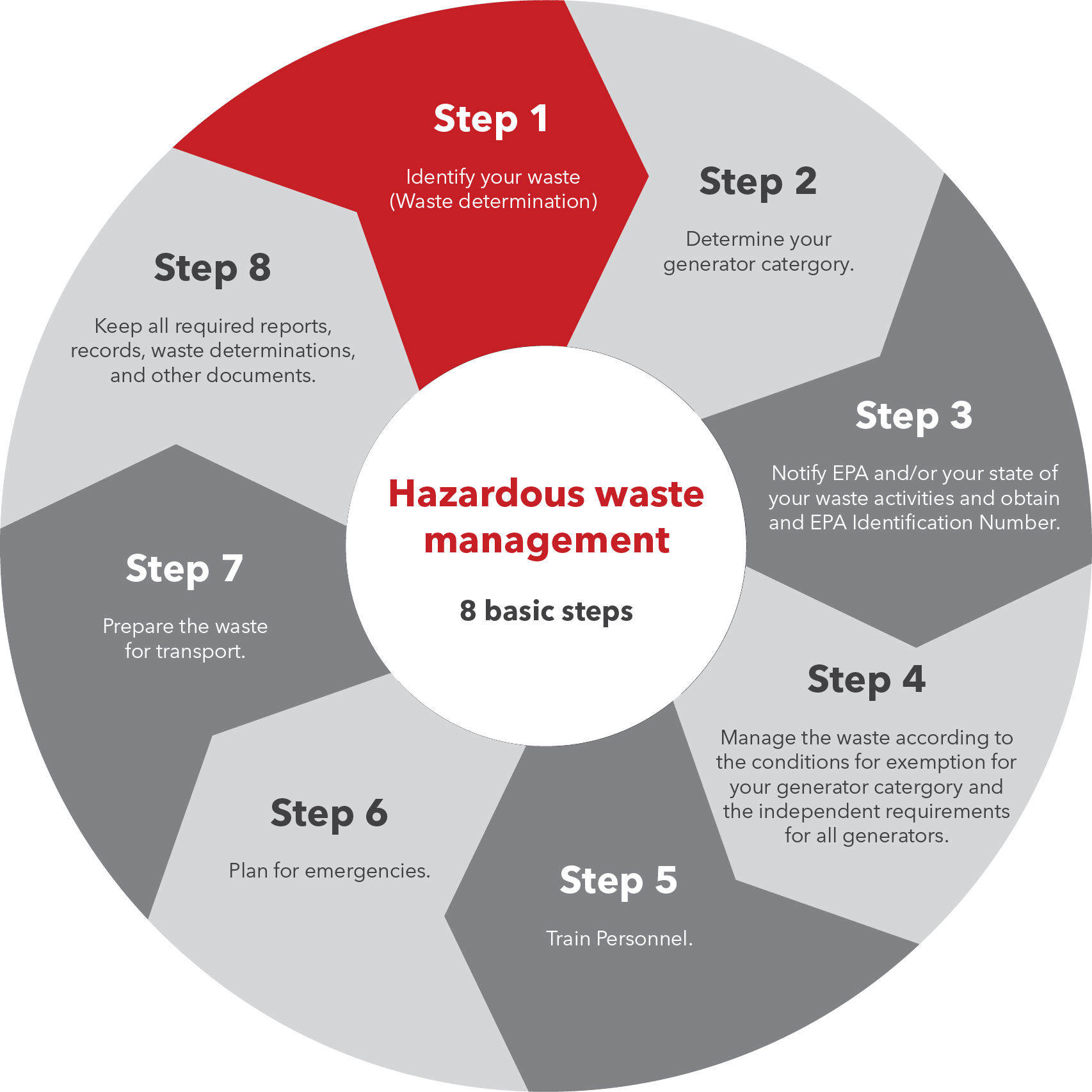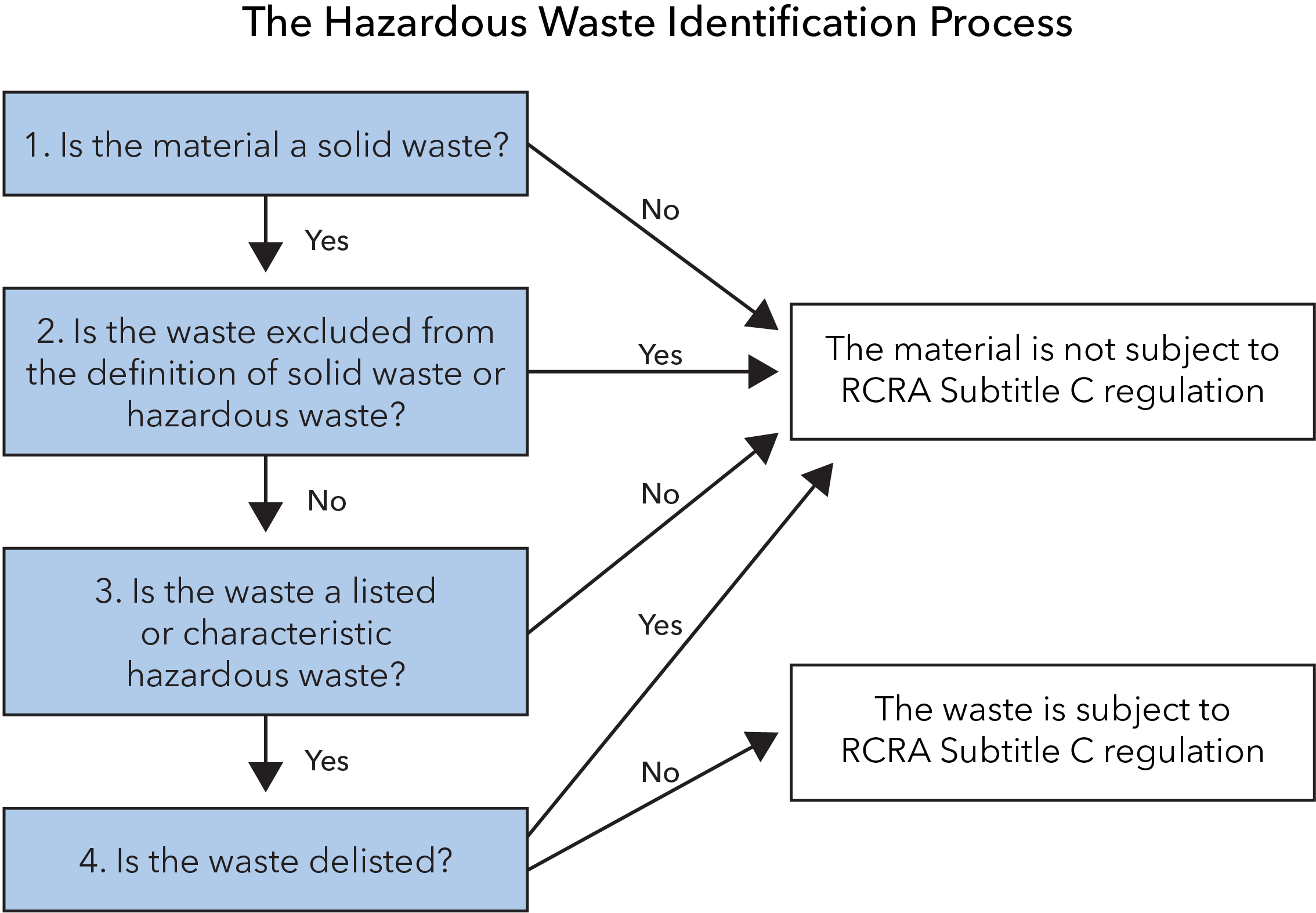Hazardous waste management: 8 basic steps
Introduction
This Fact File explains the eight basic steps of hazardous waste management. Proper management of waste is of the utmost importance for protecting the environment as well as human health and safety, and while compliance can be complex, there are eight key steps for any successful program. The first two steps in particular, identifying waste and determining your generator category, lay the foundation on which all the following steps are built. Here we identify the eight steps of hazardous waste management, with additional tips for navigating the crucial first two.
Background
The Resource Conservation and Recovery Act (RCRA) is the U.S. federal solid and hazardous waste law. “RCRA” is often used interchangeably to refer to the law, regulations, and EPA policy and guidance on waste management, and it is Subtitle C of RCRA that focuses on hazardous solid waste management requirements. These regulations ensure that hazardous waste is managed safely from the moment it is generated to its final disposal (what is known as “cradle-to-grave”). Under Subtitle C, EPA sets the criteria for hazardous waste generators, transporters, and treatment, storage, and disposal facilities (TSDFs). This includes permitting requirements, enforcement, and corrective action (or cleanup). An organization is obligated to determine the type of waste it generates and manage it in accordance with all applicable regulations.
8 basic steps for hazardous waste management

Step 1: Identify your waste (i.e., make a waste determination).
Step 2: Determine your generator category.
Step 3: Notify EPA and/or your state agency of your waste activities and obtain an EPA Identification Number.
Step 4: Manage the waste according to the conditions for exemption for your generator category and the independent requirements for all generators.
Step 5: Train personnel.
Step 6: Plan for emergencies.
Step 7: Prepare the waste for transport.
Step 8: Keep all required reports, records, waste determinations, and other documents.
Waste identification and generator category
Waste identification (also known as waste characterization) is the critical first step to proper hazardous waste management. Identification allows an organization to determine its generator category, which in turn lays a unique path for how the company must approach the rest of the eight steps of hazardous waste management.
Organizations should perform a survey to determine their waste streams — and then it’s time to determine whether the waste in any of the streams is hazardous. Companies can make this determination on their own or use the services of a consultant or waste disposal company, but the basics of identification are found in asking a series of questions about the waste. These questions — and the various conclusions that arise depending on the answer — are outlined in the flow chart below.

Your organization should also take steps to identify any federally or state recognized universal wastes, which are subject to more streamlined regulations and do not count towards accumulation totals that determine hazardous waste generator category.
Once you’ve identified that you generate hazardous waste, the next step is to determine your generator category based on the amount of waste you accumulate in a calendar month. The categories are:
- Very small quantity generator (VSQG). This category applies to organizations that generate up to 2.2 lbs. (1 kg) of acute hazardous waste; up to 220 lbs. (100 kg) of hazardous waste; and/or up to 220 lbs. (100 kg) of acute spill residue or soil per month.
- Small quantity generator (SQG). This category applies to organizations that generate up to 2.2 lbs. (1 kg) of acute hazardous waste; between 220 and 2,200 lbs. (100 to 1,000 kg) of hazardous waste; and/or up to 220 lbs. (100 kg) of acute spill residue or soil per month.
- Large quantity generator (LQG). This category applies to organizations that generate more than 2.2 lbs. (1 kg) of acute hazardous waste; more than 2,200 lbs. (1,000 kg) of hazardous waste, and/or more than 220 lbs. (100 kg) of acute spill residue or soil per month.
Once you know your generator category, you can proceed with the rest of the steps of hazardous waste management by following the federal and state regulations that apply to your organization.
Applicable laws & regulations
- 40 CFR 260 — Hazardous Waste Management System: General
- 40 CFR 261 — Identification and Listing of Hazardous Waste
- 40 CFR 262 — Standards Applicable to Generators of Hazardous Waste
- 40 CFR 268 — Land Disposal Restrictions
- 40 CFR 273 — Standards for Universal Waste Management
Related definitions
Acute hazardous waste: Any hazardous waste with a “P” waste code (or certain “F” waste codes). These wastes are subject to stringent accumulation and management requirements.
Hazardous waste: Waste with properties that make it dangerous or capable of having a harmful effect on human health and the environment. Under RCRA, hazardous wastes are specifically defined as wastes that meet a particular listing description or that exhibit a characteristic of hazardous waste (i.e., ignitability, corrosivity, reactivity, and toxicity).
Key to remember
While each of these basic steps contain their own complexities, all eight are necessary for a compliant hazardous waste management program. Properly identifying waste and correctly determining your organization’s generator category are the crucial first steps to completing all other obligations.
Real world examples
Identification of hazardous waste and hazardous waste generators are EPA and the states’ top two main focus areas of hazardous waste compliance. Violations of these requirements can lead to a domino effect, where violations related to other aspects of waste management are discovered and cited.
A laboratory operations company managing a Navy facility was hit with a $350,000 penalty for several environmental violations, including a failure to make proper waste determinations.
A Scranton, Iowa, manufacturing company agreed to pay a civil penalty of $50,208 related to RCRA violations. The root of the problem? The organization qualified as a large quantity generator of hazardous waste but was failing to meet that category’s waste management requirements.
